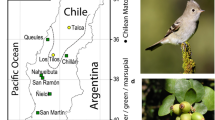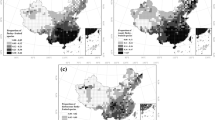Abstract
In tropical dry forests, a high interspecific variation in the strategies of fruiting phenology has been documented. Therefore, phenological responses may be mediated by influence of environmental variables, functional plant attributes or phylogenetic inertia. During 2 years, we recorded the fruiting phenology of 151 species belonging to 5 different growth forms of a Neotropical dry forest in Mexico. We evaluated the relationships between fruiting phenology, abiotic factors (precipitation, temperature, day-length) and functional attributes (growth form, dispersal syndrome, size and time for fruit development) using phylogenetic least squares models (PGLS). More species had ripe fruits during the dry season (92%) than during rainy months and dispersed their seeds by autochory and endozoochory. We found that fruit development time was positively correlated with fruit size and together the morphological fruit traits (size and dispersal syndrome) showed an important relationship with the growth form, but with a strong phylogenetic signal. Environmental seasonality had a strong influence on fruit ripening time, without a relevant association to the phylogeny of plant species. However, the phenological response to the environment (rainfall and day-length) at the community level was mediated by growth form. In woody species, we documented a high interspecific fruiting variation linked with the different dispersal syndromes. In herbaceous species, fruiting phenology is a trait restricted by the duration of their life cycle by rainfall seasonality, which in turn might have selected some traits (e.g., dry fruit, presence of spines, explosive dehiscence) for maximizing seed dispersal during the dry season.




Similar content being viewed by others
References
APG IV (2016) An update of the Angiosperm Phylogeny Group classification for the orders and families of flowering plants: APG IV. Bot J Linn Soc 181:1–20. https://doi.org/10.1111/j.1095-8339.2009.00996.x
Arredondo-Amezcua L, López-Toledo L, Ibarra-Manríquez G (2015) Espectro de dispersión de la flora leñosa del bosque tropical caducifolio en el neotrópico. Bot Sc 93:143–152. https://doi.org/10.17129/botsci.233
Batalha MA, Martins FR (2004) Reproductive phenology of the Cerrado plant community in Emas National Park (central Brazil). Aust J Bot 52:149–161. https://doi.org/10.1071/BT03098
Boulay R, Carro F, Soriguer RC, Cerdá X (2007) Synchrony between fruit maturation and effective dispersers’ foraging activity increases seed protection against seed predators. Proc R Soc B 274:2515–2522. https://doi.org/10.1098/rspb.2007.0594
Bullock SH (1995) Plant reproduction in neotropical dry forests. In: Bullock SH, Mooney HA, Medina E (eds) Seasonally dry tropical forests. Cambridge University Press, Cambridge, pp 277–303
Cortés-Flores J, Hernández-Esquivel KB, González-Rodríguez A, Ibarra-Manríquez G (2017) Flowering phenology, growth forms, and pollination syndromes in tropical dry forest species: influence of phylogeny and abiotic factors. Am J Bot 104:39–49. https://doi.org/10.3732/ajb.1600305
Davis CC, Willis CG, Primack RB, Miller-Rushing AJ (2010) The importance of phylogeny to the study of phenological response to global climate change. Philos Trans R Soc B 365:3201–3213. https://doi.org/10.1098/rstb.2010.0130
Dray S, Dufour AB (2007) The ade4 package: implementing the duality diagram for ecologists. J Stat Softw 22:1–20. https://doi.org/10.18637/jss.v022.i04
Eriksson O (2008) Evolution of seed size and biotic seed dispersal in angiosperms: paleoecological and neoecological evidence. Int J Plant Sci 169:863–870. https://doi.org/10.1086/589888
Eriksson O, Friis EM, Löfgren P (2000) Seed size, fruit size, and dispersal systems in angiosperms from the Early Cretaceous to the Late Tertiary. Am Nat 156:47–58. https://doi.org/10.1086/303367
Felsenstein J (1985) Phylogenies and the comparative method. Am Nat 125:1–15. https://doi.org/10.1086/284325
Fenner M (1998) The phenology of growth and reproduction in plants. Perspect Plant Ecol Evol Syst 1:78–91. https://doi.org/10.1078/1433-8319-00053
Freckleton RP, Harvey PH, Pagel M (2002) Phylogenetic analysis and comparative data: a test and review of evidence. Am Nat 160:712–726. https://doi.org/10.1086/343873
Griz LMS, Machado ICS (2001) Fruiting phenology and seed dispersal syndromes in caatinga a tropical dry forest in the northeast of Brazil. J Trop Ecol 17:303–321. https://doi.org/10.1017/S0266467401001201
Herrera CM (2002) Correlated evolution of fruit and leaf size in bird-dispersed plants: species-level variance in fruit traits explained a bit further? Oikos 97:426–432. https://doi.org/10.1034/j.1600-0706.2002.970312.x
Heydel F, Tackenberg O (2016) How are the phenologies of ripening and seed release affect by species’ ecology and evolution? Oikos 126:738–747. https://doi.org/10.1111/oik.03442
Howe HF, Smallwood J (1982) Ecology of seed dispersal. Ann Rev Ecol Syst 13:201–228. https://doi.org/10.1146/annurev.es.13.110182.001221
Janzen DH (1967) Synchronization of sexual reproduction of trees within the dry season in Central America. Evol 21:620–637. https://doi.org/10.2307/2406621
Jara-Guerrero A, De la Cruz M, Méndez M (2011) Seed dispersal spectrum of woody species in south Ecuadorian dry forests: environmental correlates and the effect of considering species abundance. Biotropica 43:722–730. https://doi.org/10.1111/j.1744-7429.2011.00754.x
Jurado E, Westoby M, Nelson D (1991) Diaspore weight, dispersal, growth form and perenniality of central Australian plants. J Ecol 79:811–828. https://doi.org/10.2307/2260669
Justiniano MJ, Fredericksen TS (2000) Phenology of tree species in Bolivian dry forests. Biotropica 32:276–281. https://doi.org/10.1111/j.1744-7429.2000.tb00470.x
Kuhlmann M, Ribeiro JF (2016) Evolution of seed dispersal in the Cerrado biome: ecological and phylogenetic considerations. Acta Botanica Brasilica 30:271–282. https://doi.org/10.1590/0102-33062015abb0331
Leishman MR, Westoby M, Jurado E (1995) Correlates of seed size variation: a comparison among five temperate floras. J Ecol 83:517–529. https://doi.org/10.2307/2261604
Leishman MR, Wright IJ, Moles AT, Westoby M (2000) The evolutionary ecology of seed size. In: Fenner M (ed) Seeds: the ecology of regeneration in plant communities. CABI, Wallingford, pp 31–57
Magallón S, Gómez-Acevedo S, Sánchez-Reyes LL, Hernández-Hernández T (2015) A metacalibrated time-tree documents the early rise of flowering plant phylogenetic diversity. New Phytol 207:437–453. https://doi.org/10.1111/nph.13264
Martins EP, Housworth EA (2002) Phylogeny shape and the phylogenetic comparative method. Syst Biol 51:873–880. https://doi.org/10.1080/10635150290155863
Mendoza I, Perez CA, Morellato LPC (2017) Continental-scale patterns and climatic drivers of fruiting phenology: a quantitative Neotropical review. Glob Planet Chang 148:227–241. https://doi.org/10.1016/j.gloplacha.2016.12.001
Moles AT, Westoby M (2006) Seed size and plant strategy across the whole life cycle. Oikos 113:91–105. https://doi.org/10.1111/j.0030-1299.2006.14194.x
Moles AT, Ackerly DD, Webb CO, Tweddle JC, Dickie JB, Pitman AJ, Westoby M (2005) Factors that shape seed mass evolution. Proc Natl Acad Sci USA 102:10540–10544. https://doi.org/10.1073/pnas.0501473102
Morellato LPC, Leitao-Filho HF (1996) Reproductive phenology of climbers in a Southeastern Brazilian Forest. Biotropica 28:180–191. https://doi.org/10.2307/2389073
Morellato LPC, Alberti LF, Hudson IL (2010) Applications of circular statistics in plant phenology: a case studies approach. In: Hudson IL, Keatley MR (eds) Phenological research. Springer, Amsterdam, pp 339–359
Oksanen J, Blanchet FG, Friendly M, Roeland K, Legendre P, McGlinn D, Minchin PR, O’Hara RB, Simpson GL, Solymos P, Stevens MHH, Szoecs E, Wagner H (2016) Vegan: Community Ecology Package. R package version 2.4-1. https://CRAN.R-project.org/package=vegan. Accessed 21 Jun 2016
Orme CDL, Freckleton RP, Thomas GH, Petzold T, Fritz SA (2012) Caper: comparative analyses of phylogenetics and evolution in R. http://R-Forge.R-project.org/projects/caper/. Accessed 21 Jun 2016
Primack RB (1987) Relationships among flowers, fruits, and seeds. Annu Rev Ecol Syst 18:409–430. https://doi.org/10.1146/annurev.es.18.110187.002205
R Core Team (2016) R: a language and environment for statistical computing. R Foundation for Statistical Computing. Vienna, Austria. http://www.R-project.org/. Accessed 18 Jul 2018
Ramos-Ordoñez MF, Arizmendi MDC, Márquez-Guzmán J (2012) The fruit of Bursera: structure, maturation, and parthenocarpy. AoB Plants, pls027. https://doi.org/10.1093/aobpla/pls027
Rathcke B, Lacey EP (1985) Phenological patterns of terrestrial plants. Ann Rev Ecol Syst 16:179–214. https://doi.org/10.1146/annurev.es.16.110185.001143
Rodríguez-Jiménez C, Fernández-Nava R, Arreguín-Sánchez ML, Rodríguez-Jiménez A (2005) Plantas vasculares endémicas de la cuenca del río Balsas, México. Polibotánica 20:73–99
Rzedowski J (1978) Vegetación de México. Primera edición. Editorial Limusa, Mexico
Silva IA, da Silva DM, de Carvalho GH, Batalha MA (2011) Reproductive phenology of Brazilian savannas and riparian forests: environmental and phylogenetic issues. Ann For Sci 68:1207–1215. https://doi.org/10.1007/s13595-011-0071-5
Smythe N (1970) Relationships between fruiting seasons and seed dispersal methods in a Neotropical forest. Am Nat 104:25–35. https://doi.org/10.1086/282638
Sorensen AE (1986) Seed dispersal by adhesion. Ann Rev Ecol Syst 17:443–463. https://doi.org/10.1146/annurev.es.17.110186.002303
Staggemeier VG, Diniz-Filho JAF, Morellato LPC (2010) The shared influence of phylogeny and ecology on the reproductive patterns of Myrteae (Myrtaceae). J Ecol 98:1409–1421. https://doi.org/10.1111/j.1365-2745.2010.01717.x
Staggemeier VG, Diniz-Filho JAF, Zipparro VB, Gressler E, de Castro ER, Mazine F, da Costa IR, Lucas E, Morellato LPC (2015) Clade-specific responses regulate phenological patterns in Neotropical Myrtaceae. Perspect Plant Ecol Evol Syst 17:476–490. https://doi.org/10.1016/j.ppees.2015.07.004
Stone EA (2011) Why the phylogenetic regression appears robust to tree misspecification. Syst Biol 60:245–260. https://doi.org/10.1093/sysbio/syq098
Tabarelli M, Vicente A, Barbosa DCA (2003) Variation of seed dispersal spectrum of woody plants across a rainfall gradient in north-eastern Brazil. J Arid Environ 53:197–210. https://doi.org/10.1006/jare.2002.1038
van der Pijl L (1972) Principles of dispersal in higher plants. Springer, New York
van Schaik CP, Terborgh JW, Wright JS (1993) The phenology of tropical forests: adaptative significance and consequences for primary consumers. Ann Rev Ecol Syst 24:353–377. https://doi.org/10.1146/annurev.es.24.110193.002033
Vieira DLM, Scariot A (2006) Principles of natural regeneration of tropical dry forests for restoration. Restor Ecol 14:11–20. https://doi.org/10.1111/j.1526-100X.2006.00100.x
Webb CO, Ackerly DD, Kembel SW (2008) Phylocom. Software for the analysis of phylogenetic community structure and trait evolution. Bioinform 24:2098–2100. https://doi.org/10.1093/bioinformatics/btn358
Wikander T (1984) Mecanismos de dispersión de diásporas de una selva decidua en Venezuela. Biotropica 16:276–283. https://doi.org/10.2307/2387936
Zar JH (2010) Biostatistical analysis, 5th edn. Pearson Prentice-Hall, Upper Saddle River
Acknowledgements
The first author thanks the Posgrado en Ciencias Biológicas de la Universidad Nacional Autónoma de México (UNAM) for the formation received during the course of the doctoral studies. This study is part of the doctoral research of the first author. J. Cortés-Flores also thanks to Consejo Nacional de Ciencia y Tecnología (CONACyT) for the scholarship for graduate studies. This research was supported by the Programa de Apoyo a Proyectos de Investigación e Innovación Tecnológica (PAPIIT) of UNAM, as a part of the Project IN207512 (Fenología de especies arbóreas del bosque tropical caducifolio en la Depresión del Balsas, Michoacán). Two anonymous reviewers give us valuable suggestions and comments to improve this manuscript.
Author information
Authors and Affiliations
Contributions
JCF and GIM originally formulated the idea and developed methodology, JCF, GCT and GIM conducted fieldwork, EA, GCT, LAUG developed the data analysis, EA, AGR, JCF performed statistical analyses, JCF and AGR developed phylogenetic analysis, JCF, GIM, AGR wrote the manuscript.
Corresponding author
Ethics declarations
Conflict of interest
The authors declare that they have no conflict of interest.
Ethical approval
This article does not contain any studies with human participants or animals performed by any of the authors.
Additional information
Communicated by Kendi Davies.
Electronic supplementary material
Below is the link to the electronic supplementary material.
Rights and permissions
About this article
Cite this article
Cortés-Flores, J., Cornejo-Tenorio, G., Urrea-Galeano, L.A. et al. Phylogeny, fruit traits, and ecological correlates of fruiting phenology in a Neotropical dry forest. Oecologia 189, 159–169 (2019). https://doi.org/10.1007/s00442-018-4295-z
Received:
Accepted:
Published:
Issue Date:
DOI: https://doi.org/10.1007/s00442-018-4295-z




